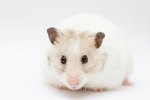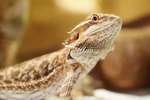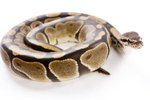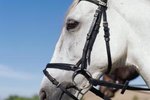
Originating from Australia's desert regions, the bearded dragon (Pogona vitticeps) was named for his ability to "puff out" his spike-covered throat until it resembles a beard. Even more impressive, the dragon's "beard" can also change color during breeding and become jet black. Dramatic in appearance, his triangular-shaped head contains rows of spikes that create a thorny crown. While the bearded dragon is considered one of the most docile of all reptile species, weighing the pros and cons of ownership can help you make the most informed decision.
Plenty of Space
Caring for a bearded dragon entails both cost and responsibility. Because bearded dragons typically grow between 12 to 24 inches long, you'll need to be able to afford a spacious tank with appropriate cage supplies. The larger the dragon's tank, the happier he'll be in captivity. For that reason, select a large 55 to 70 gallon tank with a screened lid. You'll also need to install UVB lighting to protect your dragon from bone and growth deformities. To help him feel at home, maintain the tank temperature between 75 and 80 degrees Fahrenheit and keep a separate basking area between 90 and 100 Fahrenheit. Other necessary cage supplies include a sandy substrate, and a variety of branches, rocks and plants for climbing, exploring and hiding.
Daily Feedings
Just like a dutiful parent, you'll need to ensure your bearded dragon is receiving adequate nutrition by purchasing appropriate food for his dietary needs. Your dragon can live up to 10 years, so you'll need to be able to afford to feed him for that length of time. Bearded dragons are omnivorous and require a balanced diet of both vegetable and insect food. To ensure his nutritional needs are being met, you'll need to feed him a diet of 60 to 65 percent plant foods and 30 to 40 percent insects, including crickets. Insects should be no larger than the width of your dragon's mouth to insure optimum digestion and prevent intestinal blockages from swallowing an insect too large.
Tank Maintenance
Owning a bearded dragon requires vigilant upkeep. You'll need to put time and effort into maintaining his tank so it remains a safe and clean environment. Each day, wash his food and water bowls in warm, soapy water. You'll also need to scoop out feces, leftover food and any uneaten insects out of his tank to keep it free from bacteria. If your tank only houses one bearded dragon, clean the tank and change the sand about once each month. Clean the tank more frequently if your tank holds two or more bearded dragons. When changing the sand, thoroughly clean all the other cage items, including rocks, branches and any other decorative items in his home.
Docile, Friendly and Social
All the time that goes into caring for a bearded dragon is worth the effort if you're looking for an easy-going and friendly reptile. Bearded dragons are considered one of the best reptile pets due to their good-natured disposition and mild temperament. For that reason, they generally adapt well to their human caretakers. Once your dragon becomes acclimated to his new home, he'll enjoy your company and even scurry to the front of his tank to greet you. Your dragon might display fascinating behavior, such as "arm waving." Arm waving entails lifting one of his front legs and "waving" it in the air, a form of communication believed to show submission.
Digs Being Handled
Because they're so docile, bearded dragons will typically permit handling more than most other lizard species. When you first begin training your dragon, avoid handling him for long stretches of time to lessen the potential for stress. The younger the bearded dragon is, the more anxious he might become if he's held too long. Instead, initially handle him for short periods of time, which will help him become trusting of you. Once he becomes more relaxed, you can hold him for longer stretches of time. Always lift him up from the side or underneath, never from the top. Over time, your dragon might look forward to being petted and even close his eyes while you stroke his head.
But Handle With Care
While your bearded dragon might welcome handling, you'll still need to exercise caution to avoid contracting salmonella. Bearded dragons and all other reptiles can carry the salmonella bacteria in their feces. Even in trace amounts, handling or ingesting a reptile's feces can transfer the salmonella bacteria to humans. To prevent infection, thoroughly wash your hands after touching or handling your bearded dragon, preferably with antibacterial soap. Avoid keeping the dragon in the kitchen, dining room or anywhere else where food is prepared or consumed. Always dispose of lizard feces in the toilet or trash can, never in a bathtub or sink.
References
- ReptileChannel.com: Bearded Dragon Care Sheet
- Veterinary Medical Teaching Hospital: Care of Bearded Dragons
- University of Miami Department of Biology: Caring for an Australian Bearded Dragon
- VetStreet: Caring for Bearded Dragons
- The Ann Arbor News: Bearded Dragons Make Fine Pets, But They Require Special Care
Photo Credits
-
Hemera Technologies/AbleStock.com/Getty Images




